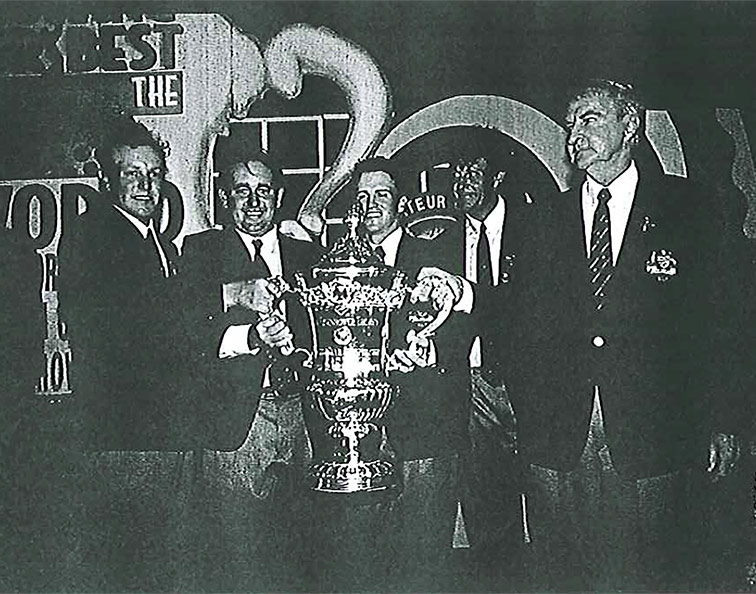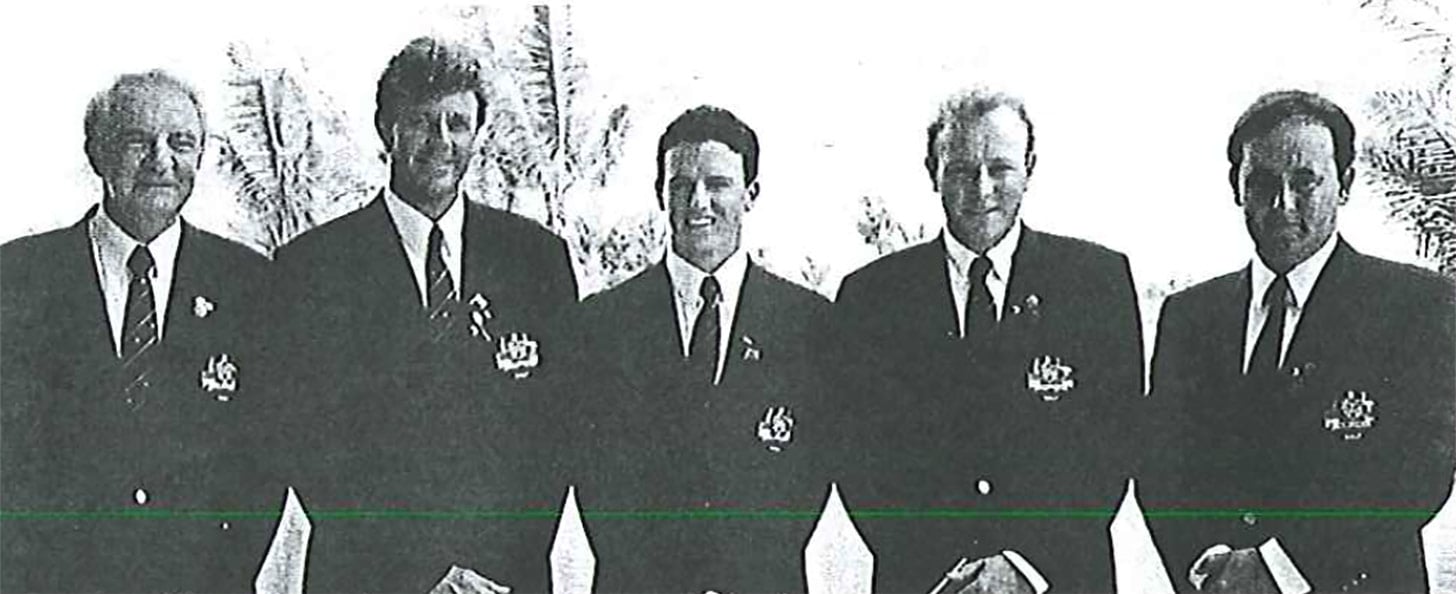Sitting on the tarmac at Sydney Airport for 90 minutes while engineers work on your aeroplane is hardly a good omen ahead of a nine-hour flight to The Philippines. But perhaps it was a portent of things to come for four Australian amateurs in 1996.
Jamie Crow, David Gleeson, Jarrod Moseley and Brett Partridge were on a mission to contest the biennial World Amateur Teams Championship. They were a diverse quartet entrusted with the task of regaining the Eisenhower Trophy for the first time since 1966.
Gleeson, 18, the reigning Australian Amateur champion, was pure talent (ambidextrous with a golf club in his hands). It was said the farmer’s son from Dalby in Queensland’s Darling Downs could have even been a concert pianist.
Moseley, 24, from Mandurah south of Perth, was a fearless competitor but a bit of a playboy who was inclined to enjoy the nocturnal activities on previous representative tours.
Partridge was described as a 25-year-old day labourer from Tasmania “whose beefy stature and callused hands hint at his work in a lumber mill”.
Crow, the oldest member of the team, was a reinstated amateur and reformed alcoholic. He would drink up to 20 cans of Diet Coca-Cola a day and used to chew Swedish tobacco. The 34-year-old Las Vegas resident was lucky to make the trip, having crashed a friend’s Porsche into a 10-foot retaining wall at Sanctuary Cove just before the team’s departure.
They were accompanied by non-playing captain Bruce Nairn, a disciplinarian and accomplished golfer. Nairn thought Australia’s chances increased when news broke that teenage hotshot Eldrick ‘Tiger’ Woods had withdrawn from the United States team to pursue a career in professional golf.

But that positive was outweighed by the inconvenience of the team’s accommodation being located in the Manila city centre, two hours’ drive from the Manila Southwoods Golf & Country Club. The tournament hotel adjacent to the course was unfinished and had room for only six of the 47 national teams. The Australians were unimpressed the American and Great Britain & Ireland teams had commandeered the on-site lodgings.
The weight of the problem hit home during a practice round when the Australians spent two hours in Manila’s notorious traffic for the 20-mile ride out to the course and another two hours in gridlock on the way back.
In an attempt to remedy the situation, one of Crow’s friends arranged for an 11-seater mini bus and driver to take the team out to the course. Nairn would set the alarm clock for 4.30am each morning and had the players on their bus by 5.15am to arrive at Southwoods by 6.00am. It still took 90 minutes for the return journey (by police escort) back to the Holiday Inn – which was barely enough time for an evening meal before an early bedtime.
Hence, the silver lining of the accommodation debacle was that the Australians had little downtime to get up to any mischief. They were focussed on the golf tournament and it paid immediate dividends.
In hot and humid temperatures, Partridge started brilliantly, shooting 65-67 to be 12-under after two rounds. Gleeson (68-69) and Moseley (70-70) offered good support, but Crow (76-78) was off his game (perhaps still shaken by the accident). The format was four rounds of strokeplay with the best three individual scores to be counted each day. That allowed Crow’s early scores to be discarded.

On day three the Australians built a formidable eight-stroke lead. Gleeson (69), Partridge (70) and Moseley (71) all played steady golf while Crow (72) showed glimpses of his best form.
With one hand on the Eisenhower, Moseley and Gleeson went off early in the final morning (as they did all four rounds) and shot 73 and 74, respectively. By mid-afternoon, the Australians had an unassailable lead of 14 strokes with nine holes to play.
Crow stood tall, shooting a superb even-par 72 in difficult, windy conditions. Partridge shot 76 playing alongside a 16-year-old Spanish prodigy by the name of Sergio Garcia (which left the Tasmanian two strokes adrift of Finland’s Kalle Aitala for individual honours).
Australia’s aggregate total of 26-under 838 was 11 strokes to the better of Sweden, with Spain 13 strokes behind in third. Surprisingly, neither the Brits (tied fifth) nor the Americans (ninth) mounted a serious challenge despite the advantage of on-course lodging.
“I really expected us to do pretty well because I thought we had a good team,” recalls Nairn. “But never in my wildest dreams did I ever think that we were going to bloody well win by the margin that we won. It was just a piece of cake.”
The five Australians were rewarded with a 10-carat gold medal and feted at the following week’s Australian Open in Sydney at The Australian Golf Club.

What happened afterwards?
Australia narrowly failed to defend the Eisenhower two years later in Santiago, Chile when a talent-laden team of Aaron Baddeley, Kim Felton, Brendan Jones and Brett Rumford finished second behind a Great Britain & Ireland side containing future world No.1 Luke Donald. But what happened to our most recent Eisenhower Trophy winners?
Gleeson, 38, turned professional in 1998 and has won three times on the Asian Tour. Currently ranked 1,350th in the world, he lives in Taipei with his Taiwanese wife and their two sons.
Moseley, 44, is married with four children (two daughters and twin boys). He has retired after competing for seven full seasons on the European Tour. His two professional victories were both significant – the 1999 Heineken Classic in Perth and the 2002 Australian PGA Championship (which he shared with Peter Lonard under controversial circumstances). For the past two years he’s been working for Kentz Electrical in the oil and gas industry on Barrow Island off the coast of Western Australia.
Partridge was Rookie of the Year in his first season on the PGA Tour of Australasia. But his pro career stalled after tearing the cartilage off his wrist in the final of the 1997 Volvo Asian Match Play. He underwent surgery but was never the same again and retired in 2000. Now 45, he has two daughters and lives in Scottsdale, Tasmania. Previously working at Barnbougle Dunes as golf operations manager for 11 years, Partridge is now a store supervisor for Serve-Ag, Tasmania’s leading agricultural advice and product supply company.
Crow continued playing at amateur level and represented Victoria. In recent years he was said to be managing a pub in Melbourne. But he has since returned to America to care for his ageing father, Tom Crow, the former Australian Amateur champion and founder of Cobra Golf.

